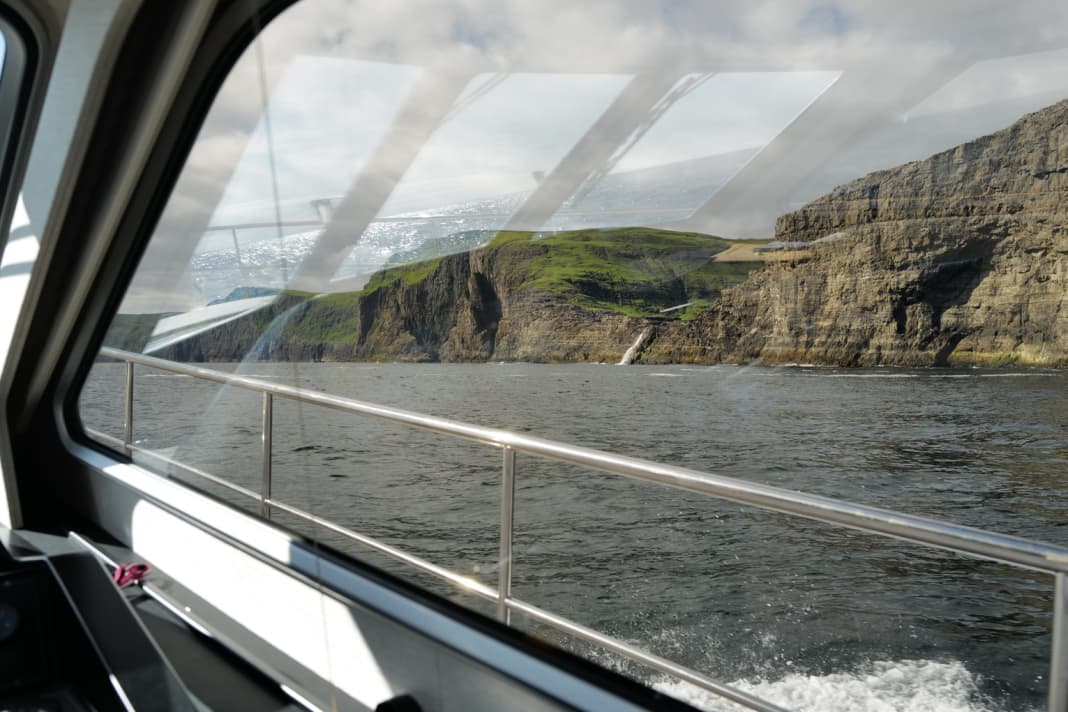





A text by Nakomis Nelson
On our second day on the Orkneys, I proposed to my partner Haley, who has a nice shot of Scottish blood in her veins, during a long walk to the famous whiskey distillery in Scapa. We celebrated and set off the next day for the Faroe Islands, another long haul that would take our Elling E6 and us across the high seas for the first time.
The Faroe Islands are a remarkable archipelago with dramatic cliffs and waterfalls amidst emerald green mountains and pastures that drop hundreds of metres into the storm-tossed sea.
The tides are not too strong, but the currents are, flowing at several knots in both directions. They create whirlpools and standing waves that should not be underestimated. We landed in Tórshavn, the capital. It is a small settlement squeezed between two steep hills and influenced by modern European influences and the old Nordic way of life.
Faroe Islands: between art and nature
We enjoyed the almost endless daylight, but I imagined how different it must be when the winter storms come and the sun barely makes it over the horizon. Tórshavn is also home to one of the best art museums I've ever had the pleasure of visiting. It's not overly large, but it's beautifully decorated with Faroese art, a real testament to the strength and vibrancy of the local culture. After a few rainy days of eating well and stretching our legs on the cobbled streets of the town, we were still waiting for a weather window for the crossing to Iceland, so we explored the island a little more by boat.
With a stiff northerly wind, the trip to the island of Vágar was well sheltered and we found a concrete jetty in Miðvágur harbour where we moored. The hike to Lake Sørvágsvatn was beautiful. Sheep roamed the grassy ground around the crescent-shaped lake. Further back, the cliffs by the sea revealed a landscape seemingly untouched by human hands. Back in Tórshavn, we had diesel delivered, topped up our fresh water tanks and ate the last few bites ashore before travelling the almost 400 miles back to Iceland.
The crossing to Iceland
Our original plan was to circumnavigate Iceland in the north, but like many of our weather windows on this trip, the one we wanted to enter was small. Instead, we aimed for the south coast and headed west under its protection to the Vestmannaeyjar archipelago. Our last view of the Faroe Islands was the lighthouse at Mykines, the westernmost point of the island chain.
Fortunately, the wind soon died down and we could assume that the swell would also subside during the night. At a cruising speed of 12 knots, we needed 32 hours for the non-stop crossing. The Elling proved to be very seaworthy and glided comfortably over the waves. Even the autopilot held its course in difficult conditions - a real testament to the work of the shipyard and the Vripack designers who created the hull. The optional Seakeeper gyro stabiliser also helped to keep the crew comfortable.
Still far off Vestmannaeyjar, a group of pilot whales appeared next to us. When we looked towards the horizon shortly afterwards, we realised that we could actually see the mountains and glaciers in the south of Iceland above the clouds.
Now, 1000 nautical miles after the start, this landfall gave us a collective feeling of elation. Our time in Iceland was to be brief, but rewarding nonetheless. Unfortunately, the owners of the yacht and their son were forced to return to the United States for work reasons, while Greenland was only a weather window away. Tears were shed and hugs exchanged as we struggled to find a third crew member.
A long-time friend and former shipmate agreed to join us while we made the final preparations: fuel, odds and ends and one last trip to the famous Blue Lagoon. I spent endless hours watching the trends on the ice charts and weather models. The information was not promising, but the trend was in the right direction. We turned the bow to the west. Our wishes had been fulfilled, the pack ice had broken up and the eastern entrance to Prins Christian Sound was clear. We steered "Archimedes" through the ice by hand and were relieved when we realised that we would make it to safety before nightfall.

